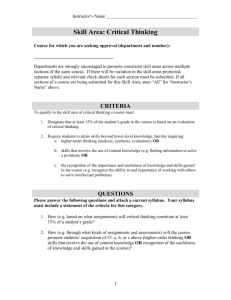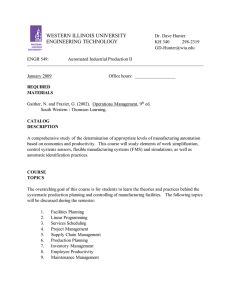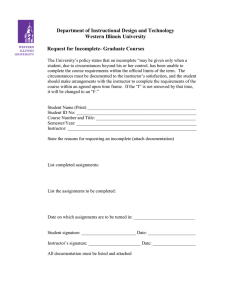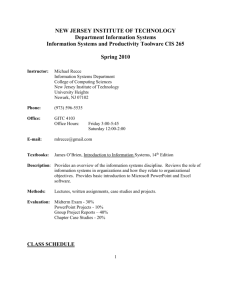Anthropology I. General Education Review – Writing Course ANTY 310
advertisement
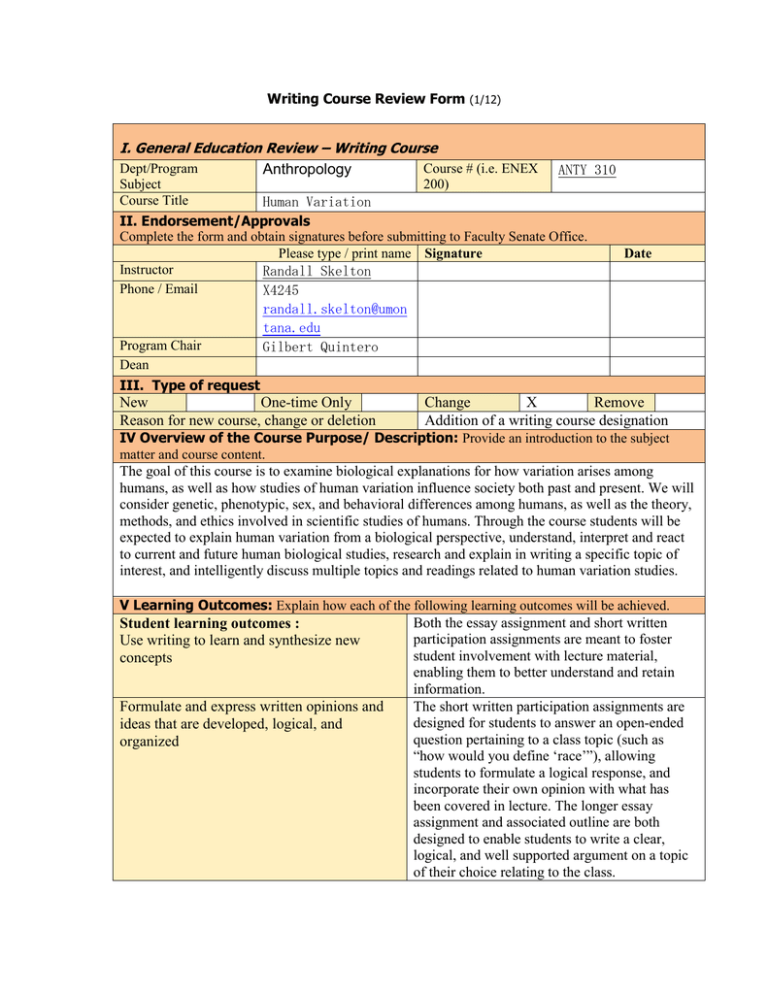
Writing Course Review Form (1/12) I. General Education Review – Writing Course Dept/Program Course # (i.e. ENEX Anthropology ANTY 310 Subject 200) Course Title Human Variation II. Endorsement/Approvals Complete the form and obtain signatures before submitting to Faculty Senate Office. Please type / print name Signature Date Instructor Randall Skelton Phone / Email X4245 randall.skelton@umon tana.edu Program Chair Gilbert Quintero Dean III. Type of request New One-time Only Reason for new course, change or deletion Change X Remove Addition of a writing course designation IV Overview of the Course Purpose/ Description: Provide an introduction to the subject matter and course content. The goal of this course is to examine biological explanations for how variation arises among humans, as well as how studies of human variation influence society both past and present. We will consider genetic, phenotypic, sex, and behavioral differences among humans, as well as the theory, methods, and ethics involved in scientific studies of humans. Through the course students will be expected to explain human variation from a biological perspective, understand, interpret and react to current and future human biological studies, research and explain in writing a specific topic of interest, and intelligently discuss multiple topics and readings related to human variation studies. V Learning Outcomes: Explain how each of the following learning outcomes will be achieved. Both the essay assignment and short written Student learning outcomes : participation assignments are meant to foster Use writing to learn and synthesize new student involvement with lecture material, concepts enabling them to better understand and retain information. The short written participation assignments are Formulate and express written opinions and designed for students to answer an open-ended ideas that are developed, logical, and question pertaining to a class topic (such as organized “how would you define ‘race’”), allowing students to formulate a logical response, and incorporate their own opinion with what has been covered in lecture. The longer essay assignment and associated outline are both designed to enable students to write a clear, logical, and well supported argument on a topic of their choice relating to the class. Compose written documents that are appropriate for a given audience, purpose and context Revise written work based on constructive comments from the instructor Find, evaluate, and use information effectively and ethically (see http://www.lib.umt.edu/informationliteracy/) Begin to use discipline-specific writing conventions Demonstrate appropriate English language usage VI. Writing Course Requirements Enrollment is capped at 25 students. If not, list maximum course enrollment. Explain how outcomes will be adequately met for this number of students. Justify the request for variance. The essay assignment is designed to be written with their classmates as their intended audience. Through this focused audience students are asked to explain material that will allow their classmates to best understand the research they carry out. This aids in their perception of how to write for a specific audience, namely their peers. The detailed outline (which should average 2-3 pages) is reviewed by the instructor for content and clarity, and allowed to be resubmitted based on feedback. The research paper for the course must be supported by at least ten sources that the student must find outside of class readings. The students are instructed on locations where they might find sources, and how to effectively utilize them to make an argument and avoid plagiarism. Citation formatting and utilizing scientific writing conventions are both aspects of the research paper assignment. Papers and assignments are all graded with an eye to English language usage, and all students are encouraged to follow established guidelines. Enrollment is approximately 40 students. The instructor has aid from a preceptor to help in handling students and basic questions on material, which has worked in the past. This number of students can be adequately taught with coursework spread out throughout the semester, with the aid of a grader/preceptor to ensure students are given the help they require. What instructional methods will be used to teach A handout that encompasses what is expected students to write for specific audiences, purposes, for written work, especially the research and genres? paper, is distributed to students. Additionally, several lectures are spent discussing topics, means to address them, and what can be done to ensure individual students perform well on their written work. I also meet individually with as many students as are interested to discuss their writing, what can be improved, and other feedback I can provide. Which written assignments will include revision in Yes, the outline may be resubmitted based on response to instructor’s feedback? feedback. VII. Writing Assignments: Please describe course assignments. Students should be required to individually compose at least 16 pages of writing for assessment. At least 50% of the course grade should be based on students’ performance on writing assignments. Clear expression, quality, and accuracy of content are considered an integral part of the grade on any writing assignment. Formal Graded Assignments Research paper: (8-10pgs)—15% of grade Outline: (2-3 pgs)—5% of grade Participation: (6pgs)—10% of grade Problem set: (3-5pgs)—10% of grade Midterm exam (essay format for approximately half)—(~2pgs) 25% of grade Informal Ungraded Assignments VIII. Syllabus: Paste syllabus below or attach and send digital copy with form. For assistance on syllabus preparation see: http://teaching.berkeley.edu/bgd/syllabus.html The syllabus must include the following: 1. Writing outcomes 2. Information literacy expectations 3. Detailed requirements for all writing assignments or append writing assignment instructions Paste syllabus here. Anthropology 310: Human Variation _____ Semester 201_ Instructor: Dr. Meradeth Snow Meradeth.snow@umontana.edu Office Hours: 2-5pm in 219 Social Sciences & by appointment. Class Information: Tuesdays and Thursdays 11:10am-12:30pm in 344 SS Class Preceptor: TBA Textbook & Readings: Molnar, SJ. 2006. Human Variation: Races, Types and Ethnic Groups, 6th Edition. Upper Saddle River, NJ: Prentice Hall. ISBN# 0-13-192765-5. Supplemental readings will be posted on the course Moodle site. These will provide material for discussion in class or discussion section. The Purpose of Anthropology 310: The goal of this course is to examine biological explanations for how variation arises among humans, as well as how studies of human variation influence society both past and present. We will consider genetic, phenotypic, sex, and behavioral differences among humans, as well as the theory, methods, and ethics involved in scientific studies of humans. Through the course students will be expected to explain human variation from a biological perspective, understand, interpret and react to current and future human biological studies, research and explain in writing a specific topic of interest, and intelligently discuss multiple topics and readings related to human variation studies. Grades: Exams: Midterm Exam: 25% Final Exam: 30% Research Paper: Outline: 5% In-class presentation: 5% Research Paper: 15% Problem Set: 10% Participation: 10% Examinations: The midterm exam will be primarily made up of term identifications, short answer, and short essay questions. The final exam will be entirely composed of multiple choice questions. The midterm exam will test your knowledge and understanding of material covered from the start of class through Week 7. The final exam will test your knowledge and understanding of material covered during weeks 8-15, including the presentations of student papers. Although the final is not technically cumulative, you may find terms and examples from the first half of the class helpful on the final exam as many concepts are cumulative. Research Paper: Your research paper will be written on a topic of your choice—something of interest to you within the realm of human biological variation, including all topics covered in this course. You are encouraged to talk to your instructor about your topic to ensure that it is suitable. You should have your specific topic chosen by the midterm, and a significant amount of research completed before you turn in your outline. Outline: The goal of the outline is to ensure that your research is on schedule for you to complete your paper to the best of your ability. Additionally, it allows your instructor the chance to ensure your topic is adequate and direct you to any major points you may be missing in your research. The outline will be a two-three page, typed document outlining your paper. Each paragraph you plan to write in your should have a line on the outline that specifies the main topic of that paragraph; in others words, in reading your outline your instructor should have a concrete view of your paper and research topics when finished. You will be allowed to re-submit your revised outline based on your professor’s comments and advice. Presentation: It is important that you leave college with the ability to synthesize and present research you have accumulated. For this reason, a brief, five-minute presentation will be required of each student at the end of the quarter, covering the topic you chose for your paper. These presentations will also be possible subject matter for the final exam and attendance is highly recommended. Paper: The research paper should be approximately eight to ten pages (no longer than 12 pages, double spaced, 12 point Times font, 1” margins—it is obvious if you stray from these guidelines) and include literature citations, both in-text and as a Works Cited. It should consist primarily of new information not presented in class. Sources used to write your paper should include journal articles and books but no websites other than online journals. You will be graded on the level of scholarship reflected by the paper, its relevance to the course, clarity and thought put into the paper, support provided, writing style, and mechanics. The research paper will be due on the last day of class (May 9th). Problem Set: The problem set assigned to you will be distributed via Moodle and will cover information presented during the first half of the course. You will be asked to apply formulas and reason out problems applicable to human variation studies. A practice problem set will be distributed prior to this for you to complete and which will be solved during week 5. You will be graded on your work, how well it is labeled, your explanations, and the answers you obtain. This problem set may take quite a bit of time— do not wait until the last minute to begin! Participation: The participation portion of the class will be based on your contribution to classroom discussions that will take place throughout the semester. These will be primarily composed of answering written questions, which will then be discussed as a group. Your attendance and thoughtful and respectful analysis of the assigned readings for the classroom discussion will be counted toward your grade. Several weeks will also have small assignments that will accompany the reading—these will be announced widely in class.
